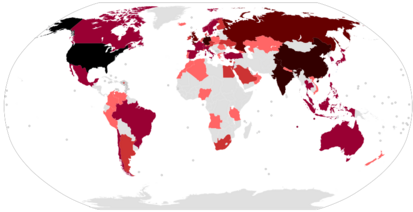This article contains several duplicated citations. (August 2024) |

High-net-worth individual (HNWI) is a technical term used in the financial services industry for people who maintain liquid assets at or above a certain threshold. Typically, they are defined as holding financial assets (excluding their primary residence) valued over US$1 million.[1][2] A secondary level, a very-high-net-worth individual (VHNWI), refers to someone with a net worth of at least US$5 million.[1] The terminal level, an ultra-high-net-worth individual (UHNWI), holds US$30 million in investible assets (adjusted for inflation).[3][4] Individuals with a net worth of over US$1 billion are considered to occupy a special bracket of the UHNWI.[2][5] These thresholds are broadly used in studies of wealth inequality, government regulation, investment suitability requirements, marketing, financing standards, and general corporate strategy.
As of December 2023[update], it was estimated that there are just over 16 million HNWIs in the world, according to the World's Wealthiest Cities Report 2024 by Henley & Partners. The United States had the highest number of HNWIs (5.5 million) of any country, with California, Texas, New York, Florida, and Illinois domiciling the majority stateside. New York City is the wealthiest and most populous city, with 349,500 HNWIs.[6] UHNWIs constitute only 0.003% of the world's population and hold 13% of the world's total wealth.[7] In 2017, 226,450 people were designated as UHNWI, with their combined total wealth increasing to $27 trillion.[8]
- ^ a b Staff, Investopedia (19 April 2020). "High-Net-Worth Individual (HNWI)". Investopedia. Retrieved 2020-11-10.
- ^ a b "World Wealth Report 2020" (PDF). Capgemini. Archived (PDF) from the original on 2020-11-10. Retrieved 2020-11-09.
- ^ Cite error: The named reference
:2was invoked but never defined (see the help page). - ^ Grzeskiewiecz, Grzegorz; Tomasz Kozlinski (15–17 June 2004). "High Net Worth Individuals: The Clients of Private Banking" (PDF). 8th International Conference of Doctoral Students. Brno University of Technology (Czech Republic). Archived from the original (PDF) on 24 March 2012. Retrieved 6 March 2014.
- ^ Neate, Rupert (2022-09-20). "Number of global ultra high net worth individuals hits record high". The Guardian. ISSN 0261-3077. Retrieved 2023-03-05.
- ^ "World's Wealthiest Cities Report 2024". 2024.
- ^ Staff, Investopedia (2013-08-30). "Ultra High Net Worth Individual (UHNWI)". Investopedia. Archived from the original on 2017-10-26. Retrieved 2017-10-27.
- ^ Cite error: The named reference
wealthx_2017_reportwas invoked but never defined (see the help page).